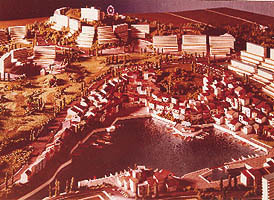
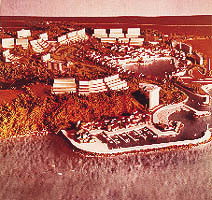
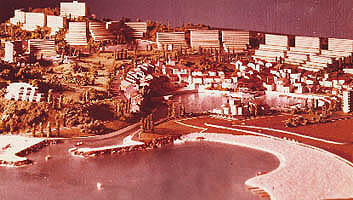
Juan Antonio García Solera
| La
Cala |
 |
 |
 |
Juan Antonio García Solera |
|
Sobre terrenos situados en los términos municipales de Finestrat y
Villajoyosa, en el entorno de Benidorm, fue encargada la actuación
urbanística aconsejable para ponerlos en valor. La propuesta y desarrollo
del proyecto elegido por la propiedad fue encargada a Juan Antonio García
Solera, colaborando con él Juan José Arostegui, arquitecto.
Se hicieron las siguientes reflexiones de las que deducir los criterios que sirviesen de base para planear la actuación: La provincia de Alicante, por razones de clima —vientos secantes y cadena montañosa paralela a la costa—, tiene una fuerte implantación turística a lo largo de todo el litoral, desde Denia a Torrevieja. En contraste con los otros grandes desarrollos españoles —Costa del Sol, Mallorca, Canarias— predomina en Alicante el apartamento y el chalet adquiridos principalmente para uso permanente, siendo el equipamiento hostelero más bien escaso y concentrado exclusivamente en Benidorm. En general, puede estimarse que la calidad económica del residente y del turista es media o media baja. Existe un grado alto de estacionalidad y predominio de permanencia de personas. Benidorm constituye una excepción dentro del conjunto turístico provincial. Gran dotación hostelera y de apartamentos en alquiler. Como contrapartida, existen algunos inconvenientes: aglomeración excesiva, defectos de infraestructura y abastecimientos, congestiones de tráfico, etc. El terreno de que se disponía podía en principio, por su extensión y volumen a edificar, servir para un desarrollo de más alto nivel, ya que se estimó que la distancia a Benidorm es adecuada y los condicionamientos negativos podían ser modificados. Para ello se fijaron algunos supuestos: Implantar un estilo arquitectónico antitético de Benidorm. Huyendo del verticalismo; había que lograr formas similares a la de los pueblos mediterráneos, con desarrollo en horizontal, pocas alturas y juego de volúmenes. No se precisaba introducir materiales de construcción costosos. La calidad puede lograrse con el juego de formas y la armonía, gusto y gracia del conjunto. El planteamiento urbanístico tenía que promover el contacto entre las gentes. Sin caer en la aglomeración, debía evitarse la sensación de soledad y aislamiento. Planificar los espacios e instalaciones necesarios que posibilitaran la práctica de deportes variados, de tierra y mar, actividades de tipo social y recreativo, así como diversiones y espectáculos. Por último, se consideraba necesario dotar la zona de algún o algunos puntos atractivos que fueran poco usuales o inexistentes en la misma, como por ejemplo: marina, puerto deportivo, helipuerto, golf, gran centro comercial, SPA, etc. La distribución de las superficies a construir debía ser: La mayor parte del volumen, edificado en los bordes del polo de atracción a crear, ocupando el semicírculo en forma de anfiteatro que presenta el terreno. En la cornisa alta paralela a la Costa se podría edificar apartamentos más costosos y un hotel. Las zonas forestales se destinarían a grandes parcelas de más de 5 000 m², para viviendas unifamiliares aisladas. Escoger las zonas de menos vistas para su dedicación a centro deportivo, viviendas de empleados y administración. La zona comercial de la urbanización, debía estar integrada en núcleo o núcleos urbanos, sitos en las zonas bajas de alguno de los edificios, en ningún caso aislada y agrupada en un sólo lugar. La razón es la vida real que esto proporciona. Apoyadas en estas reflexiones y criterios se plantearon a la propiedad tres soluciones distintas cuyo mayor diferenciador era que el polo de atracción que se consideraba imprescindible para activar una actuación atrayente fuese: –una marina interior De ellas, analizando ventajas e inconvenientes, la propiedad aceptó la solución de Marina y se desarrolló el proyecto íntegramente. Se exponen las sucintas memorias diferenciadoras, desarrollando más ampliamente la solución elegida que expone e incluye además aquellas zonas comunes a las tres actuaciones. Solución Marina Dadas las características topográficas del terreno, en el que existe un macizo montañoso en la línea del frente al mar, se consideró la posibilidad de crear una marina interior cortando el mismo y vaciando el anfiteatro natural, como medio de revalorización de todos los terrenos interiores. De esta forma se lograría una actuación urbanística brillante cuyo principal foco de atracción sería la citada Marina, emplazada en el centro geométrico del terreno, y rodeada de topografía suave y respaldada por macizos más acusados entre los que destaca el de la costa, cuya espalda con arbolado abundante sería un telón de fondo de indudable interés. El emplazamiento urbanístico era, por tanto, el desarrollo de una urbanización residencial alrededor de una marina, en cuyo perímetro se situaba el centro comercial como elemento vivo del conjunto. En esta marina se plantearon agrupaciones de apartamentos con servicio de atraque de embarcaciones. Como complemento, en la costa se planteó la creación de un puerto deportivo a mar abierto para embarcaciones de mayor calado, y con su apoyo, el desarrollo de un "poblado de pescadores" cuyo destino apartamental reviste indudable interés. Los promontorios que respaldan al anfiteatro natural, citados anteriormente, permiten situar sobre los mismos, como elementos destacados, un Club de montaña, un Club deportivo y Restaurante-cafetería junto a un antiguo torreón situado en al macizo costero. Entre estos macizos y la marina, deslizándose por la topografía y adaptándose a ella se proyectaron los grupos de bungalows y apartamentos, con alturas reducidas, y los chalés de más categoría utilizando la ladera sur, poblada de arbolado. Sobre la ladera recayente al mar, se ubicó un hotel de cinco estrellas, así como una agrupación de apartamentos que, dada su importancia, habría que cuidar mucho. El viario establecido es muy concreto y dinámico: una vía rápida que atenazando la Marina y por detrás de sus edificaciones, daba servicio fluido a toda la urbanización. Esta vía principal de tráfico se complementaría con otra malla secundaria que daría servicio a los puntos de interés citados anteriormente, así como al resto de zonas edificables. Ventajas Justificaba la posibilidad de pedir la concesión del puerto, etc., al aportar un terreno privado. La excavación de la marina permitía rellenar el puerto de forma más económica. La gran unidad urbanística, encajada en el anfiteatro, con grandes espacios libres de construcción. Permitía adaptar la construcción a la topografía del terreno. Esta solución encajaba en el carácter de la zona. Inconvenientes Posibles problemas jurídico-administrativos (similares a los del puerto). Técnicamente se consideraba factible, pero sus costes y ritmo de ejecución podrían variar mucho, en función de la naturaleza de los terrenos a excavar y de la costa en que han de asentarse la plataforma y el puerto. Solución Lago Se consideró la posibilidad de crear una Red de lagos interior vaciando en parte el anfiteatro natural, como medio de revalorización de todos los terrenos interiores. Estos lagos estarían comunicados entre sí, mediante canales o cascadas que harían circular el agua mediante una estación impulsora ubicada en la parte baja, junto a la costa. Se lograría una actuación urbanística cuyo principal foco de atracción sería los citados lagos, emplazados en el centro geométrico del terreno, y rodeados inmediatamente de topografía suave, y respaldados por macizos más acusados. El Planteamiento urbanístico es, por tanto, el desarrollo de una urbanización residencial alrededor de una red de lagos, en cuyo perímetro se sitúa el centro comercial como elemento vivo del conjunto. Como complemento del foco de atracción anterior, en la costa se planteó la creación del puerto deportivo a mar abierto para embarcaciones de mayor calado. Ventajas El impacto estético podría ser superior por el movimiento de planos de la topografía de terreno. Permitía cantidad de agrupaciones urbanas, formando poblados de una manera más flexible. Coste de ejecución menor que la marina. Inconvenientes Peligro de salinización de jardines en capas freáticas interiores. Problema de que la calidad del terreno obligara a grandes impermeabilizaciones. Precisaba ciertos costes de conservación y mantenimiento, si bien no muy altos, además de los propios de las obras a realizar en sus márgenes. Solución Golf Como atracción de toda la Urbanización, se proyectó un Campo de golf de 18 agujeros, situado en el anfiteatro natural que forma el terreno y subiendo suavemente hacia las laderas que lo circundan. El Club de Golf se ubicaría en un punto dominante con airosa situación y perfecto emplazamiento respecto al campo. Las viviendas a construir se dispondrían sobre distintas zonas, las que se agruparían intensivamente alrededor del puerto a modo de poblado de pescadores; las que se plantearon aisladas con edificación en chalets, dentro del sector con vegetación ya conseguida, y el resto, como solución intermedia, se agrupaba en bloques de apartamentos de los montículos perimetrales del terreno. El viario se compuso de una vía principal que, accediendo desde la carretera general de Alicante a Valencia, recorrería dinámicamente la urbanización hasta el puerto deportivo, actuando como vía direccional al mismo. Ventajas Agradable como zona verde en medio de un paisaje árido. Podía aprovecharse el 10% de zona verde que, en otro caso, había que reservar. La realización técnica era más simple que en cualquier otra solución. Inconvenientes No aportaba nada nuevo desde el punto de vista urbanístico. Hacía perder la unidad a la urbanización, que quedaba partida en dos zonas. Dificultades de agua. Iba contra la idea general planteada porque habría que construir edificios en alturas probablemente de diez plantas y con gran concentración. La Marina En la solución elegida, este proyecto fue desarrollado íntegramente, no realizándose por el freno que la situación económica del momento impuso. Corría el año 1973. |
An
assessment of recommendations/proposals for the urban development of land
situated within the municipality of Villajoyosa, in the surrounding area
of Benidorm, was commissioned. The proposal and the development of the
project chosen by the owners was commissioned to Juan Antonio García
Solera, with the collaboration of the architect Juan José Arostegui.
The following was taken into account in deciding what criteria would be of use in planning the project: The province of Alicante, due to its climate -dry winds and a mountain range that runs parallel to the coast - has a large amount of tourist type development all along its coast, from Denia to Torrevieja. In contrast with other large development areas in Spain - the Costa del Sol, Majorca, the Canary Islands - houses and apartments in this area are purchased mainly for permanent use; hotel type installations are scarce and are concentrated exclusively in Benidorm. In general, it can be stated that the economic level of the residents and of the tourists is middle or lower middle class. Activity is predominantly of a seasonal nature and there is also a predominance of continued residence. Benidorm is an exception within the provincial tourist complex. An extensive offering of hotels and rental apartments. In contrast, there are a few inconveniences: excessive crowding, defects in infrastructure and supplies, traffic congestion, etc... The land in question could, in principal, because of its size and the volume to be constructed, be used for a higher level type of development, in that it is considered that the distance from Benidorm is adequate and the negative conditioners could be modified. With all this in mind, the following was decided: Introduce an architectural style antithetical to that of Benidorm. Avoiding the verticality of Benidorm, forms similar to those of the Mediterranean villages would be obtained, with a horizontal development, few stories, and a play on volumes. It would not be necessary to use costly construction materials. The quality would be obtained through the play on forms and harmony, good taste and elegance of the complex. The urban approach would have to promote contact among the people. Without falling into a situation of crowding, the sensation of isolation and solitude should be avoided. Planning of the necessary space and installations to make it possible to practice a variety of sports, on the land and on the sea, activities of a social and recreational type, as well as entertainment and diversion. Finally, it was deemed necessary to provide the area with some attractive points that were unusual or non-existent in the area, such as for example: marina, recreational port, heliport, golf, large shopping centre, spa, etc... The distribution of the surfaces to be constructed should be: The greatest proportion of the volume should be built on the borders of the pole of attraction to be created, occupying the semi-circular amphi-theatre form of the land. In the high cornice that runs parallel to the coast more expensive apartments and a hotel could be built. The forested areas for large plots, more than 5,000 m2, for the construction of individual single family residences. Select the less exposed areas for use as sports centre, housing for employees, and administration. The commercial area of the housing estate development should be integrated into the lower areas of the buildings, and in no case should they be isolated or grouped into only one area. The reason for this is the real life this gives to the development. Basing our recommendations on these reflections and criteria, we suggested to the owners three different solutions in which the greatest differentiating feature was that the pole of attraction that we considered essential in order to activate an attractive effectuation would be: –An
interior marina After having considered the advantages and disadvantages of each of the proposals, the owners accepted the Marina as the ideal solution, and the project was developed in its entirety. We have included brief descriptions of each of the different solutions, developing in greater detail the solution that was adopted, including a description of those areas common to the three effectuations. The Marina Solution Given the topographical characteristics of the land, in which there is a mountainous massif in the line in front of the sea, it would lend itself to the creation of an interior marina, cutting through the massif and emptying the natural amphi-theatre, as a way of increasing the value of the interior sections of the land. In this way it would be possible to produce a brilliant urban effect. The main focus of attraction would be the Marina, situated in the geometric centre of the land, and surrounded by a gentle topography, backed up by more pronounced massifs, especially those of the coast, whose background with abundant foliage would provide a very interesting setting for the development. The approach, then, is for the development of a housing estate around a marina, and within its perimeter a shopping centre as a dynamic, living element of the complex. Within this marina there would be groups of apartments with docking service for boats. Complementary to this, the creation of a recreational port on the open seafront for larger craft is proposed, and with the support of this installation, the development of a "fishermen’s village", where the building of apartments would undoubtedly be highly attractive. The promontories behind the natural amphi-theatre, mentioned above, would be ideal for the situation of other interesting elements such as a Mountaineering Club, a Sports Club, and a Restaurant next to an old tower which is situated on the coastal range. Between these peaks and the marina, flowing down the topography and adapting to it, groups of bungalows and apartments are in the plans, of low height, and houses of a higher standing using the south, wooded side. A 5 star hotel would be built on the side that gives off to the sea, and also a group of apartments. Due to the importance of their location, care would have to be taken to build them with style and quality that would fit in with and complemement the luxury hotel ambience. The network of roads is very concrete and dynamic: a rapid roadway to serve the Marina and behind it its buildings, which would provide fluid service to the whole development. This main roadway for traffic is complemented by another secondary network that would provide daily service to the points of interest mentioned before, as well as to all of the other areas suitable for building. Advantages Justifies the possibility of asking for the concession of the port, etc., in that a private stretch of land is being provided. The excavation of the marina would allow for the more economical filling of the port. The great urban unity, set in the amphi-theatre, with large free areas for construction. Allows for the adaptation of the construction to the topography of the land. The solution fits in with the character of the area. Disadvantages Possible legal-administrative problems (similar to those for the port). Technically feasible, but the cost involved and rhythm of construction varies considerably, due to the nature of the land surfaces to be excavated and of the coast where a platform and the port have to be constructed. The Lake Solution The possibility of creating a Network of lakes was considered, by emptying out part of the natural amphi-theatre, as a way of increasing the value of the interior land plots. These lakes would be joined to each other, by means of canals or water-falls that would produce the circulation of the waters,...by means of a booster station situated on the lower part, next to the coast. This would produce an urban effectuation whose main focus of attraction would be the Lakes, situated in the geometric centre of the land, and surrounded by a gentle topography with the most pronounced peaks of the mountain range in the background. The urban approach here, then, is the development of a housing estate around a network of lakes, in the perimeter of which there would be a shopping centre as the dynamic, living element of the complex. Complementary to the above described focus of attraction, the creation of a recreational port on the open seafront for larger craft is proposed. Advantages The aesthetic impact could be favourable due to the movement of the topography of the land. Allows for a number of urban groupings, forming... in a more flexible way. Cost of execution is lower than the cost for the marina. Disadvantages Danger of salinization of gardens in layers... Problem that the quality of the land makes a large amount of waterproofing necessary. Implies certain costs for conservation and maintenance,... in addition The Golf Solution An 18 hole Golf Course is planned as the attraction for the housing estate development, situated in the natural amphi-theatre formed by the land and which rises gently to the hillsides that surround it. The Golf Club would be placed in a dominant point with a graceful situation and perfect site in relation to the course. The housing facilities would be arranged over a variety of areas, those grouped together around the port like a fishermen’s village; individual houses are under consideration for the sector with vegetation that would be obtained, and the rest, as an intermediate solution, grouped in low blocks of apartments that would be adapted to the foothills of the perimetric hillocks of the land. The roadways network would consist of a main road which, accessed from the A-road from Alicante to Valencia, runs dynamically through the development until it reaches the recreational port, acting as a directional thoroughfare to the port itself. Advantages Very pleasant as a green zone in the midst of an arid landscape. The 10% of the green zone can be taken advantage of, which in other cases would have to be reserved. The technical realisation is simpler that any other solution. Disadvantages Does not provide anything new from the urbanistic point of view. The unity of the housing estate development is lost. It would be divided into two zones. Difficulties with water. It goes against the general idea proposed in that it would mean building high rise structures with probably 10 stories and considerable concentration. The Marina The plans for the solution that was chosen, the Marina, were completely developed, but the project was not carried out due to the slowdown imposed by the economic situation at that time. This was around the year 1973. |
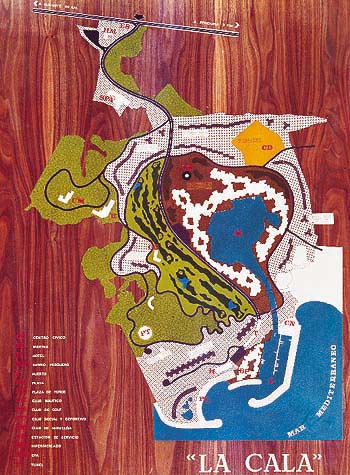 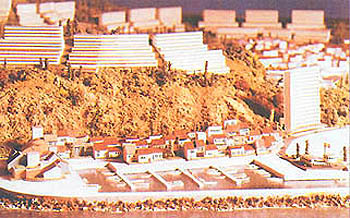 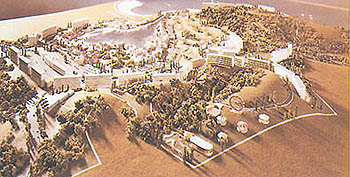 |
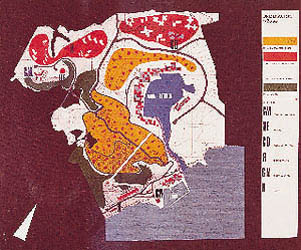 |
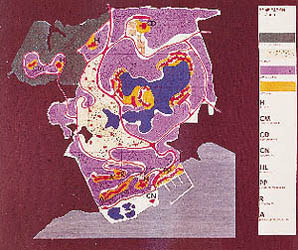 |
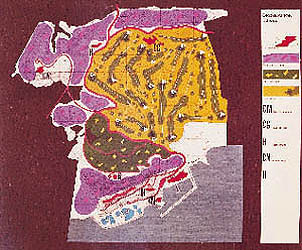 |